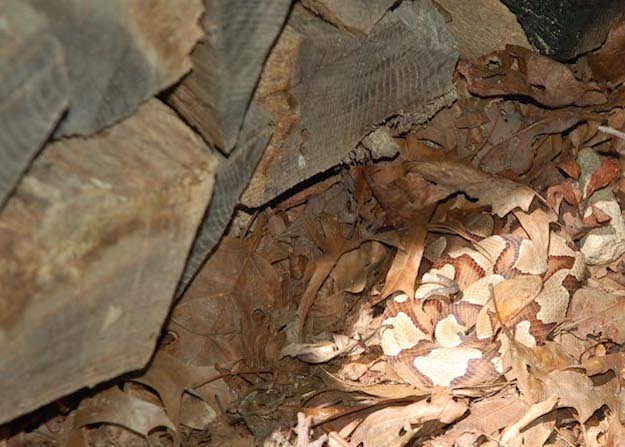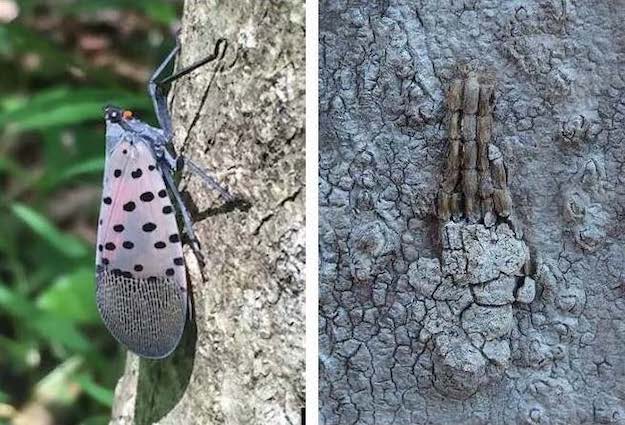
97.9 The Hill and Chapelboro.com have partnered with Orange County Master Gardeners for “Playing in the Dirt,” a monthly column exploring the fertile ground of home gardening in our community and intended to provide the information and inspiration gardeners of all skills levels need to flourish! Check back on Chapelboro each month for a new subject – from our gardens to yours!
By Margaret Alford Cloud, Orange County Master Gardener volunteer
The Playing in the Dirt team loves the happy side of gardening — pretty blooms, plentiful veggies or a good pile of compost! But this month we’re thinking about a few garden problems: Drought, copperheads and a destructive new pest. Like most difficulties in life, the more understanding you have, the easier it is to handle them. So, let’s dig in!

A cornfield during drought conditions. Heat and drought stress plants, making them vulnerable to diseases and pests. (University of Wisconsin Extension.)
A Drought-Tolerant Garden
This summer already has brought us extended stretches of temperatures in the 90s. Recent soaking rains have improved drought conditions in Orange County: The northwestern corner of the county is still listed as “abnormally dry” (an improvement from last week’s “moderate drought”) but conditions in the most of the county are now listed as normal.
A drought is a prolonged period of dry weather that leads to crop damage and water supply shortages. Heat and drought stress plants, making them more vulnerable to pests.
You can’t control the weather but you can take steps to help your garden tolerate dry, hot conditions:
Plant in the fall. Cool, damp weather is a great time to plant shrubs, trees and most perennials. The plant gets extra moisture from winter rain and snow, helping roots get established.
Amend your soil. When you prepare the soil before you plant, add organic materials such as compost, manure, leaf mold and pine bark soil conditioner. They will improve the soil’s texture, help it absorb water, increase nutrients and allow easier root growth. Test the soil before you add organic materials; more information is in a previous Playing in the Dirt column about soil, linked below.
Plant drought-resistant plants. If you want to minimize maintenance and water use, select plants that can tolerate hot, dry conditions. Some native plants are a good choice. Most native plants (those that have developed in an area over many years) have adapted to the local climate and can manage in dry conditions without extra care. They also may be more resistant to pests and diseases. The North Carolina Botanical Garden has a list of North Carolina native plants that thrive in dry conditions. (Link below.)

Adding a few inches of mulch to your garden will keep roots cool, help retain moisture and control weeds. (Photo by Margaret Cloud)
Mulch your garden. Mulch retains moisture and keeps the soil from overheating. Roots stay cool and damp. Mulch also cuts down on weed growth, which can sap moisture from the soil. Keep mulch 6 inches away from the trunks of trees and shrubs.
Water with care. Take your time to water slowly and deeply to let water soak into the ground; this can promote deep roots. Use soaker hoses or a sprinkler that keeps the water close to the ground. Water plants in the early morning or in the evening so that water doesn’t evaporate quickly. Morning watering is preferable; in the evening, leaves stay wet longer, which may lead to mildew and other fungal diseases.
Water pots frequently. Plants in pots, especially unglazed clay pots, dry out quickly and usually need more frequent watering than those in the ground.
Control weeds. Keep your garden weeded so that weeds aren’t competing for moisture.
Treat plants with care. Don’t add fertilizer during dry, hot weather. Trim dead growth. Fruits and vegetables need consistent watering to produce well. If some plants are struggling (particularly annuals or vegetables that are at the end of their productive period), pull them out.
More information:
- Gardening for a Drought: North Carolina Native Plants to the Rescue. North Carolina Botanical Garden.
- Plants That Tolerate Drought. Clemson Cooperative Extension.
- Selection and Use of Stress-Tolerant Bedding Plants for the Landscape. North Carolina Cooperative Extension.
- North Carolina Drought Advisory. North Carolina Drought Management Advisory Council.
- Watering – Efficient Irrigation for New Plants. Orange County Master Gardener volunteers.
- It’s All About The Soil. Leigh Simpson, Playing in the Dirt (August 2021), chapelboro.com.

Can you spot the copperhead in the leaf debris? (Photo by Jodie Owen, North Carolina Wildlife Resources Commission)
Coexisting With Snakes
An Orange County Master Gardener volunteer was startled recently when a copperhead slithered from a garden bed where she was working. She was not bitten but it made us ponder how to deal with snakes in the garden.
Snakes are part of our ecosystem and help control rodent, slug and insect populations. Of 38 species of snakes in North Carolina, only six are venomous. In our area, copperheads are the most common venomous snakes.
Copperheads are brown and have hourglass markings that look like Hershey’s Kisses. Their eyes have vertical elliptical pupils (similar to cat eyes). Young copperheads, usually born in late summer or fall, have a yellow or green tail.
Copperheads like wooded areas, pine straw, dried leaf litter, stacked stone walls, wood or brush piles and dense ground covers. They can be well-disguised against mulch or leaves and are most active at dusk or in the evening.
Safety tips:
- To discourage snakes in your garden, remove nearby piles of wood or rocks, or stack them on a raised platform. Mow grass and make open paths through your garden beds.
- Be careful when reaching down for a tool or pulling weeds. Long-handled tools help.
- Wear boots or closed-toe shoes, especially if you are out after dark.
- If you see a snake, leave it alone and walk away. Don’t try to kill it or pick it up, state wildlife officials say. Spray it gently with a garden hose if you need it to move.
- If you are bitten by a copperhead, move away from the snake and sit down quietly (movement or agitation makes venom circulate more quickly in your body). Go to an emergency room right away.
More information:
- Amphibians and Reptiles of North Carolina: Copperhead, NC Partners in Amphibian and Reptile Conservation.
- A Venomous Snake Just Bit You! Now What? (Includes a helpful video.) UNC Health Talk, UNC Health.
- Advice When Seeing a Snake Outdoors. North Carolina Wildlife Resources Commission.
- North Carolina Snake FAQ. Alvin Braswell, Curator Emeritus of Herpetology, North Carolina Museum of Natural Sciences.

At left, an adult spotted lanternfly. The photo on the right shows a covered egg mass (lower right) that looks like mud. After the eggs hatch, the covering of the egg mass is gone and the eggs can be seen in columns (upper right). (Photos by Emelie Swackhamer, Pennsylvania State University, bugwood.org)
Watch For The Spotted Lanternfly
The spotted lanternfly (Lycorma delicatula), an invasive, destructive insect, has been found for the first time in North Carolina. In late June, an infestation of lanternflies was found over a 5-mile radius in Kernersville (Forsyth County, west of Greensboro). State officials are working to control the pests.
Please watch out for the lanternflies since they are now relatively close to Orange County. They attach their eggs to smooth manmade surfaces as well as trees or other plants.
Use an online form (linked below) to make a report if you see an adult, nymph or egg mass. State agriculture staff will respond quickly. The North Carolina Cooperative Extension’s resource page (below) includes good photos.
Spotted lanternflies, natives of Asia, damage grapevines, hops, trees (including fruit trees) and landscape plants. They feed on more than 100 species of plants. They don’t kill the plant but they pierce it and eat from it, weakening the plant and making it vulnerable to other stresses.
Spotted lanternflies don’t bite or sting. They can be a big nuisance when they swarm, disrupting outdoor events or activities.
In North Carolina, adult lanternflies might be seen from late summer through November. Egg masses may be seen from mid-October through spring.
They often spread because their egg masses are on firewood or other materials that have been moved long distances. If you buy firewood, make sure it has been cut within a 50-mile radius; if you’re camping or traveling, don’t bring firewood home with you.
More information:
- Spotted Lanternfly Reporting Form. North Carolina Department of Agriculture and Consumer Services.
- Spotted Lanternfly (resource page). North Carolina Cooperative Extension.
Check us out!
Have a plant or garden question? Email the Orange County Master Gardener Volunteers at ocmgardeners@gmail.com or phone 919-245-2061.
Subscribe to The Garden Buzz, the Orange County Master Gardeners’ monthly newsletter, for local gardening news, events and tips. And visit our website, The Orange Gardener.
Save the date: The Orange County Master Gardener Volunteers will hold PlantFest, a plant sale and festival, on Oct. 8, 2022, 9 a.m. to 2 p.m., at 1020 US 70 W, Hillsborough, NC 27278.
Chapelboro.com does not charge subscription fees, and you can directly support our efforts in local journalism here. Want more of what you see on Chapelboro? Let us bring free local news and community information to you by signing up for our biweekly newsletter.

